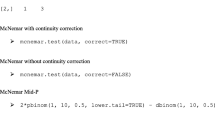Abstract
An investigator planning a QTL (quantitative trait locus) experiment has to choose which strains to cross, the type of cross, genotyping strategies, and the number of progeny to raise and phenotype. To help make such choices, we have developed an interactive program for power and sample size calculations for QTL experiments, R/qtlDesign. Our software includes support for selective genotyping strategies, variable marker spacing, and tools to optimize information content subject to cost constraints for backcross, intercross, and recombinant inbred lines from two parental strains. We review the impact of experimental design choices on the variance attributable to a segregating locus, the residual error variance, and the effective sample size. We give examples of software usage in real-life settings. The software is available at http://www.biostat.ucsf.edu/sen/software.html.

Similar content being viewed by others
References
Belknap JK(1998) Effect of within-strain sample size on QTL detection and mapping using recombinant inbred mouse strains. Behav Genet 28, 29–38
Broman KW (2001) Review of statistical methods for QTL mapping in experimental crosses. Lab Anim 30(7), 44–52
Broman KW, Wu H, Sen S, Churchill GA (2003) R/qtl: QTL mapping in experimental crosses. Bioinformatics 19, 889–890
Cox D, Hinkley D (1974) Theoretical Statistics Chapman and Hall: London
Darvasi A (1998) Experimental strategies for the genetic dissection of complex traits in animal models. Nat Genet 18, 19–24
Dupuis J, Siegmund D (1999) Statistical methods for mapping quantitative trait loci from a dense set of markers. Genetics 151, 373–386
Flint J, Valdar W, Shifman S, Mott R (2005) Strategies for mapping and cloning quantitative trait genes in rodents. Nat Rev Genet 6, 271–286
Ihaka R, Gentleman R (1996) R: A language for data analysis and graphics. J Comput Graph Stat 5, 299–314
Kearsey M, Pooni HS (1996) The Genetical Analysis of Quantitative Traits Chapman and Hall: London
Lynch M, Walsh B (1998) Genetics and analysis of quantitative traits Sinauer Associates Inc.: Sunderland, MA
Purcell S, Cherny SS, Sham PC (2003) Genetic Power Calculator: design of linkage and association genetic mapping studies of complex traits. Bioinformatics 19, 149–150
Rapp JP (2000) Genetic analysis of inherited hypertension in the rat. Physiol Rev 80, 131–172
Sen S, Satagopan JM, Churchill GA (2005) Quantitative trait loci study design from an information perspective. Genetics 170, 447–464
Silver LM (1995) Mouse genetics Oxford University Press: Oxford
Acknowledgments
The authors thank two anonymous reviewers for helpful comments on this article and the software. They thank Cynthia Piontkowski for editorial assistance. Their work was supported by NIH grants GM060457 (JMS), GM074244 (KWB), and GM070683 (GAC).
Author information
Authors and Affiliations
Corresponding author
Rights and permissions
About this article
Cite this article
Sen, Ś., Satagopan, J.M., Broman, K.W. et al. R/qtlDesign: inbred line cross experimental design. Mamm Genome 18, 87–93 (2007). https://doi.org/10.1007/s00335-006-0090-y
Received:
Accepted:
Published:
Issue Date:
DOI: https://doi.org/10.1007/s00335-006-0090-y




